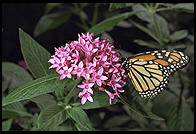

Both butterflies and moths make up an insect group named Lepidoptera.
The butterfly has 4 stages to its life. These stages of development are the egg, larva, pupa, and adult.
The butterflies' eggs are very tiny and almost invisible. Following mating, the female lays eggs on plants that will provide offspring with food once they hatch. While laying eggs, the female fertilizesthe eggs with sperm she has stored in her body after mating.

The larva or caterpillar hatches and begins eating immediately. Iteats the shell of the egg that held it and then starts eating greenplants. A caterpillars body has 14 segments. The first segment is the head. The next 3 segments make up the thorax. The last 10 segments make up the abdomen.
The larva stage lasts 2 weeks.
Once a caterpillar reaches its full growth it is ready to begin the next stage of its existence, the pupa stage. To get ready for this stage, the butterfly finds a shelter, usually a leaf, and deposits a sticky substance from its spinneret. This liquid hardens.The exoskeleton begins to split near the head and the pupa comes outof the exoskeleton. At first, the pupa is soft but gradually a hard shell forms over it. The pupa is sometimes called chrysalis. The pupa appears to be lifeless, but is actually changing into a butterfly. Thepupa stage varies according to species, ranging from a few days to a year or more.

The adult gives off fluid to help dissolve the covering. The thoraxswells and cracks and the adult emerges from the shell.
The butterfly species found in the Laurel Lake area include: Great Spangled Fritillary, Aphrodite Fritillary, Meadow Fritillary, PearlCrescent, Question Mark, Eastern Comma, Mourning Cloak, American Lady,Red Admiral, Red-spotted Purple, Little Wood Satyr, Common Wood Nymph.Monarch, Silver-spotted Skipper, Peck's Skipper, Tawny-edged Skipper,Long Dash, Little Glassywing, Hobomok Skipper, Dun Skipper, PipevinaSwallowtail, Zebra Swallowtail, Eastern Tiger Swallotail, West Virginia White, Cabbage Butterfly, Clouded Sulpher, Orange Butterfly, American Copper, Banded Hairtreak, Eastern-tailed Blue, and Spring Azure varieties.